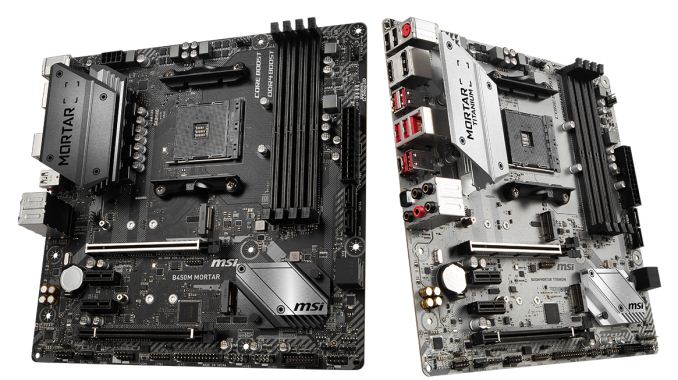Analyzing B450 for AMD Ryzen: A Quick Look at 25+ Motherboards
by Gavin Bonshor on July 31, 2018 8:00 AM ESTMSI B450M Mortar and
MSI B450M Mortar Titanium
Like the MSI B450M Bazooka boards, the MSI B450M Mortar and the B450M Mortar Titanium are a part of the MSI Arsenal Gaming collection with the focus being on offering gamers a lower cost alternative and starting point for an e-Sports based gaming system. Unlike the B450M Bazooka and Bazooka Plus models, the only differences between both the B450M Mortar models come in the aesthetics; the B450M Mortar Titanium has a classy silvery PCB and pairing of heatsinks which gives it a unique look. Both boards also have RGB LEDs implemented underneath right-hand side of the board with the option add an additional two 5050 RGB LED strips.

The MSI B450 Mortar (left) and B450 Mortar Titanium (right) motherboards
The B450M Mortar/Mortar Titanium are both microATX form factor, with support for AMD 2-way CrossFire multi-graphics card configurations. The PCIe on the boards consist of a full-length PCIe 3.0 x16 slot with MSI’s Steel Armor slot reinforcement, and a second full-length PCIe 2.0 x4 slot; also included is two PCIe 2.0 x1 slots. Storage wise both models have four SATA right angled ports and two M.2 slots with both slots supporting M.2 2280 (22 x 80 mm) drives, but only one of the slots offering full PCIe 3.0 x4 support. The second slot has support for PCIe 2.0 x4, with both M.2 slots supporting SATA drives too.
Power delivery wise, the B450 Mortar/Mortar Titanium looks to have seven phases running in a 4+3 configuration. Power to the CPU is provided by an 8-pin ATX 12 V power input while the motherboard takes power from a regular 24-pin ATX connector.
Up to DDR4-3466 memory is supported with a total of four memory slots offering a maximum system memory capacity of up to 64 GB. The boards also have a total of four 4-pin fan connectors with one being dedicated to the CPU and the rest set aside as system fan headers.
Both the B450M Mortar and B450M Mortar Titanium share identical rear panels with a two USB 3.1 10 Gbps ports (Type-A and Type-C), four USB 3.1 5 Gbps Type-A ports and two USB 2.0 ports. A pairing of video outputs with support for the Ryzen and Zen based APUs include an HDMI 1.4 port and a DisplayPort. A BIOS Flashback+ button is also included, with a PS/2 combo port, five 3.5mm audio jacks and a S/PDIF optical output and single RJ45 LAN port.
The B450M Mortar offers decent quality controllers and it’s expected that these will cost slightly more than the other microATX B450 Bazooka/Bazooka Plus pairing, but with support for 2-way CrossFire multi-graphics configurations, the B450M Mortar and B450M Mortar Titanium could comfortably be the foundations of a powerful microATX gaming system.























62 Comments
View All Comments
sh009vf5ik1a - Saturday, January 18, 2020 - link
Heads up on the Gigabyte B450 DS3H...This article pretty clearly states ECC memory is supported on this board, and so does Gigabyte's product page, however it fails to mention that 'supported' means just boot support. The actual Error Checking and Correction features are missing and unable to be leveraged.
I purchased this board purely based on this article for the sole reason of having a cheap ECC setup. Combined it with a Ryzen 2600 and Unbuffered Kingston ECC memory, and found that its impossible to get ECC working.
The system boots and works, but you do not get ECC functionality.
chrcoluk - Monday, August 30, 2021 - link
I read on reddit someone wrongfully stated the 2nd 16x slot is only pci gen 2. I wondered how they got this info, I then came across this review, which also states the 2nd 16x slow is gen 2.According to the manual both slots are gen 3 and both are hooked to the cpu.
I have confirmed this as I now use an asmedia 1604 sata card, on post it reports what pci-e mode its in, if I use any of the x1 slots it reports gen 2 x1, if I use either of the x16 slots it reports gen 3 x1 (its limited to one lane). I actually have even moved the gpu to the second x16 slot as its easier to plug in cables to the sata card when its in a higher slot and even gpuz reports the gpu is on pcie gen 3.
Whats the lesson? read the manual, test and dont take what a media rep tells you for gospel ;)